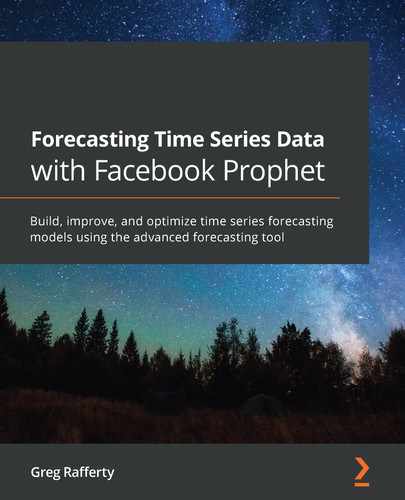Create and improve high-quality automated forecasts for time series data that have strong seasonal effects, holidays, and additional regressors using Python Prophet enables Python and R developers to build scalable time series forecasts. This book will help you to implement Prophet's cutting-edge forecasting techniques to model future data with higher accuracy and with very few lines of code. You will begin by exploring the evolution of time series forecasting, from the basic early models to the advanced models of the present day. The book will demonstrate how to install and set up Prophet on your machine and build your fi rst model with only a few lines of code. You'll then cover advanced features such as visualizing your forecasts, adding holidays, seasonality, and trend changepoints, handling outliers, and more, along with understanding why and how to modify each of the default parameters. Later chapters will show you how to optimize more complicated models with hyperparameter tuning and by adding additional regressors to the model. Finally, you'll learn how to run diagnostics to evaluate the performance of your models and see some useful features when running Prophet in production environments. By the end of this Prophet book, you will be able to take a raw time series dataset and build advanced and accurate forecast models with concise, understandable, and repeatable code. This book is for data scientists, data analysts, machine learning engineers, software engineers, project managers, and business managers who want to build time series forecasts in Python. Working knowledge of Python and a basic understanding of forecasting principles and practices will be useful to apply the concepts covered in this book more easily.Key Features
Book Description
What you will learn
Who this book is for
Table of Contents
- Forecasting Time Series Data with Facebook Prophet
- Contributors
- About the author
- About the reviewers
- Preface
- Section 1: Getting Started
- Chapter 1: The History and Development of Time Series Forecasting
- Chapter 2: Getting Started with Facebook Prophet
- Section 2: Seasonality, Tuning, and Advanced Features
- Chapter 3: Non-Daily Data
- Chapter 4: Seasonality
- Chapter 5: Holidays
- Chapter 6: Growth Modes
- Chapter 7: Trend Changepoints
- Chapter 8: Additional Regressors
- Chapter 9: Outliers and Special Events
- Chapter 10: Uncertainty Intervals
- Section 3: Diagnostics and Evaluation
- Chapter 11: Cross-Validation
- Chapter 12: Performance Metrics
- Technical requirements
- Understanding Prophet's metrics
- Mean squared error
- Root mean squared error
- Mean absolute error
- Mean absolute percent error
- Median absolute percent error
- Coverage
- Choosing the best metric
- Creating the Prophet performance metrics DataFrame
- Handling irregular cut-offs
- Tuning hyperparameters with grid search
- Summary
- Chapter 13: Productionalizing Prophet
- Other Books You May Enjoy
